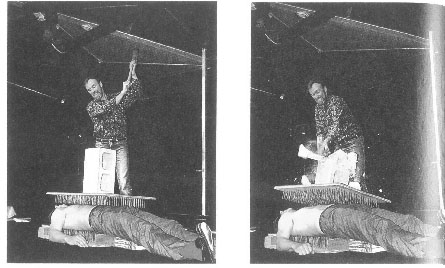Methodology
Our study included three steps: 1. the design of an intervention teaching program which modified the traditional lecture using an interactive teaching approach; 2. the implementation of the intervention program, and 3. the evaluation of the learning outcomes of the intervention teaching program in comparison with those of the traditional lecturing.
- Design of an interactive teaching program
The strategies and the design details of the intervention teaching program (ITP) are based on the current literature of science education and our understanding of the existing situation of university physics education in Taiwan. They can be described as follows:
In each lecture (50 mins), the ITP provided the students with 4-7 concept questions and sufficient time to think about and discuss these questions.
For example, in one unit the lecturer/researcher started by presenting the OHP transparency shown in Figure 1 and was looking for the corresponding concepts that explained why the man lying down could survive the impact. A concept question was then posed to the students:

Figure 1 An OHP transparency for concept test (Hewitt 1998)
Which physics quantity was conserved during the action? (a) energy, (b) force, (c) momentum (Epstein, 1983)14.
The students were then asked to think about the problem individually, to discuss with their neighbours, and then discuss with the whole class. During the whole-class discussion, the lecturer went through each alternative, and the students raised hands to indicate their selections. A few students then volunteered an explanation of the reasons for their selections. After the questioning and discussion procedure, the instruction was given explaining the corresponding concepts. The time spent on each unit varied from 10 minutes to 20 minutes, while students' participation in thinking and discussion took up about 30% of the teaching time overall.
The structure of the ITP may look similar to programs reported in the literature15, but two major differences in this program need to be highlighted.
Firstly, the lecturer in the ITP always posed the concept questions before explaining the corresponding theory, ie, the sequence of questioning before teaching16
was used. This is different from most of the research in interactive teaching in university physics, which is normally based on the conventional sequence of
teaching before questioning17. The new teaching sequence aimed to create cognitive challenge for the students18 considering their stronger physics background.
Secondly, the questions discussed in class were mostly context-rich. These questions provided familiar contexts, which were related to the students' everyday life, but were less explicit stated of the variables leading to the answers than the traditional problems, found in the back of the textbook chapters19. In other words, the context-rich questions are more challenging but are more meaningful for students' cognition. The literature in science education has highlighted the necessity of providing familiar contexts for students to construct a meaningful understanding of the concepts20. Resources of context-rich questions can be found in the literature of physics education21.
Meanwhile, the ITP teaching drastically reduced the time spending on working through exercises, which is dominated by mathematical derivation22. This strategy can save valuable teaching time for students to think and discuss.
- Implementation of the ITP
The program was implemented at the commencement of the academic year to take advantage of the students' original positive learning attitudes. The ITP was taught by one of the authors (Chang) in one class. The program was implemented for only three weeks, 9 teaching hours.
- Evaluations of the learning outcomes
The learning outcomes of both the traditional teaching and the ITP were evaluated and compared in three ways. Firstly, 14 intervention students were interviewed during and after the implementation of the ITP regarding their perceptions of the interactive teaching design and comparing it with their experiences in high school physics. Secondly, immediately after the program, 53 intervention students and 327 students in seven traditional classes, taught by different lecturers, filled in a questionnaire evaluating the teaching design as well as their attitudes to learning. The questionnaire included both open-ended and closed questions. The closed questions used a five point Likert scale. Thirdly, the students' academic achievements were evaluated by a standardised test, called
Mechanics Baseline23, administered to the intervention class and two traditional classes before (pre-test) and after (post-test) the program.
To diminish the participating students' hesitations and encourage them to express their genuine perceptions of the program, the researcher gave two statements before conducting the survey and the interviews: (1) the purpose of this study was to investigate the strengths and weaknesses of the innovative teaching program and seek ways to improve current teaching, rather than to recruit positive comments to "prove" that the program is superior to the traditional ones, (2) the researcher will not be involved in their grading procedure.

